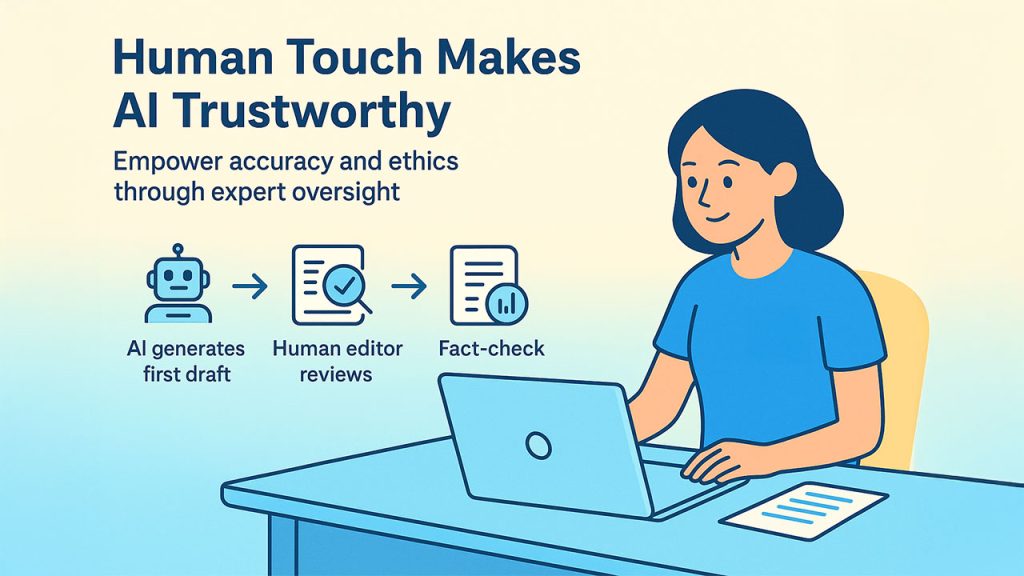Artificial intelligence (AI) is redefining the way businesses craft and segment content, providing unprecedented speed and efficiency. From creating marketing content to streamlining reports, AI tools foster teams to generate
Artificial intelligence (AI) is redefining the way businesses craft and segment content, providing unprecedented speed and efficiency. From creating marketing content to streamlining reports, AI tools foster teams to generate vast amounts of text effortlessly. However, this convenience presents potential risks—particularly when ensuring the precision and integroty that define professional communication.
Companies must double-check and very everything from factual accuracy to human-like tone and credibility since AI-generated content has become more prevalent. Tools such as GPT detector can help detect and recognize paragraphs generated through AI, but human oversight remains the ultimate safeguard. Eliminating the use of AI is not the main goal; instead, it must be guided towards authentic and responsible business interaction.
The Rise of AI in Business Communication
Artificial Intelligence is transforming how businesses interact, run market and perform their business operations. AI-powered tools such as ChatGPT, Copy.ai and Jasper occupy the central place in many businesses' workflows. They assist with many tasks – ranging from writing captions for social media platforms to generating detailed reports. However, this convenience is accompanied by a pressuring challenge that is to make sure of the accuracy and authenticity of AI-generated business content.
In a digital landscape where customer loyalty is driven by trust, even a small factual error can greatly harm the company’s reputation. AI offers speed which can tempt organizations to use it to publish content faster but it might not always be accurate. Human verification is necessary to ensure that errors or misleading claims don’t slip through. On the other hand, accuracy alone isn’t enough for business content. Authenticity is an essential aspect, and it is more than just factually correctly content. Authenticity means consistently expressing and maintaining a company’s voice, tone and value, something which AI algorithms still cannot master.
To understand why these factors matter, consider how businesses rely on content for critical purposes:
- Investor relations: Financial updates and reports must be 100% accurate.
- Marketing: Campaigns must align with brand tone and audience requirements.
- Internal communication: AI-generated policies or updates must reflect clarity and professionalism.
In summary, Efficiency can be enhanced by AI, but even though it cannot replace human judgment. Businesses must strike a balance between automation and credibility which defines the real success of modern business communication.
Quick Tip: Treat AI as a co-writer, not an independent author. Manually review and verify the content to ensure accuracy, relevancy, and credibility of messages.
Understanding the Challenges: Accuracy vs. Authenticity

“Authenticity” and “accuracy” are often used interchangeably; but they represent distinct yet equally crucial aspects of responsible AI-generated content.
Accuracy means the information must be factually correct, fresh, relevant, and extracted from reliable sources. AI models are trained on huge text data, and sometimes the generated information is typically plausible but incorrect, which is known as hallucinations. This is what renders AI unsuitable for claims that are not verified, including statistics or financial reports.
Authenticity, by contrast, represents voice, tone, style, and intent. A message may still sound mechanical or inconsistent with a brand’s voice even if it is accurate. Authenticity makes it possible for audiences to connect with content which reflects genuine human insight rather than automated texts.
The key challenges that businesses encounter are:
- Outdated training data: Many AI tools give outdated information that may not be relevant to the latest trends or reflect current regulations.
- Overgeneralization: AI oversimplifies difficult topics, which may result in partial, incomplete, or misleading explanations.
- Brand mismatch: Content that is tone-deaf or “AI-like” diminishes audience trust.
- Bias risks: AI may unintentionally replicate stereotypes or cultural insensitivity from its training data.
| Challenge | Impact on Business | Solution |
| Factual inaccuracy | Harms credibility and misleading information | Implement multi-step human fact-checking |
| Tone inconsistency | diminishes brand identity | Provide AI with tone/style guidelines |
| Lack of originality | Minimizes audience engagement | Use AI content as base draft, add original meaningful insights |
| Bias or ethical errors | PR and reputational risk | Conduct content bias audits |
Recognizing these pitfalls at an early stage can help companies set realistic expectations for AI-generated content—treating it as a starting point rather than a final output.
Human Oversight: The Key to Reliable AI Output

It is impossible to remove human oversight despite the sophistication of AI. Companies that rely on only AI tools, devoid of editorial control, leave themselves open to reputational and even legal risks. The most reliable approach combines AI efficiency with human expertise.
The three critical layers of oversight are:
- Editorial Review: Every output from AI, whether it be a blog or client report, should be subject to human editors who can check facts, gauge tone, and analyze structure.
- Fact-Checking: All data points, statistics, and names mentioned by AI are verified by human reviewers for accuracy using credible sources.
- Compliance & Legal Checks: Mostly critical in regulated industries, such as finance or healthcare, AI output checks against laws and company policies.
Example workflow for AI-assisted content creation:
First, in Step 1, AI generates the first draft based on a clear, prompt-guided brief.
Step 2: Human editor reviews and rewrites sections requiring accuracy or nuance.
Step 3: Compliance officer or project manager approves the final version.
These layered verification systems enhance quality and accountability in many ways. Nowadays, several organizations set up AI content review teams that comprise marketing professionals, editors, and compliance specialists.
Checklist for Human Oversight
- Check every factual statement.
- Review tone for consistency with brand voice.
- Avoid using repetitive or 'filler' phrases.
- Check for plagiarism/ unoriginal phrasing.
- Industry Regulations Compliance
Ultimately, human judgment is what makes AI text a trusted communication asset.
How to Ensure Authenticity in Brand Voice and Messaging

Authenticity is the emotional and strategic power of business content. With AI, delivering that authentic voice means taking deliberate steps to do so. Machines can mimic patterns, intuitively sensing what makes this brand different from another is beyond their capacity-unless we teach them.
Proven techniques to enhance AI authenticity:
- Feed the model with your brand materials: provide AI with sample emails, blog posts, or press releases that will help it understand the tone and structure.
- Create templates for prompts that include tone of voice guidance such as this: Write in a confident, conversational tone aligned with a modern B2B brand.
- Editing tools such as Grammarly Business or Writer can be used to mold the AI-generated content into the verbiage that best represents a brand when using an AI blog generator.
- In general, personalization cues will involve the addition of data points or anecdotes that only your brand could impart to make it unique from generic AI text.
Here's typically how tone alignment works:
| Desired Brand Tone | AI Prompt Example | Outcome |
| Professional & data-driven | “Write a concise product update using formal business language.” | Factual, corporate tone |
| Friendly & customer-focused | “Explain this service as if you’re helping a client solve a problem.” | Warm, supportive tone |
| Innovative & bold | “Present this feature as a groundbreaking solution that redefines industry standards.” | Energetic, visionary tone |
Continuous feedback is important, too. Encourage your marketing or communication team to review AI drafts on a regular basis and refine the prompts or input data of the model. These iterations would make sure the content really reflects your brand's personality.
By controlling the tone, structure, and intent of the message, businesses will ensure that AI works for the brand, not against it.
Ethical and Practical Standards for Governance of AI-Generated Content
Creating business content responsibly with AI goes beyond editing-it needs a governance framework that defines how, when, and why AI is employed. Ethical oversight protects both the company and its audience.
Key elements of an AI content governance policy:
- Usage Guidelines: Explain what AI can be used for and what needs to be done fully by humans, like drafts, internal notes, or FAQs.
- Verification Protocols: Create an internal guideline to guarantee that accuracy, data verification, and brand voice are consistent.
- Disclosure of AI involvement, when appropriate, in content creation ensures honesty with clients and readers.
- Bias Detection: This is done through regular testing of AI outputs for discrimination or other biased perspectives.
- Accountability Measures: A responsible reviewer or manager should be assigned for all AI-generated documents.
A basic governance model might look something like the following:
| Stage | Responsible Role | Objective |
| Content Generation | AI tool | Create the initial draft |
| Editing & Review | Content Editor | Ensure clarity and tone |
| Fact Verification | Research Analyst | Confirm data accuracy |
| Compliance Check | Legal/Compliance Officer | Verify alignment with regulations |
| Final Approval | Communications Director | Approve for publication |
Beyond internal policy, ethics dictate transparency and ongoing monitoring. Businesses should document the use of AI tools and keep up with regulations associated with digital content and data usage.
As AI continues to improve, so will the standards for authenticity, reliability, and fairness. The companies that invest in responsible AI communications today will become the leaders of tomorrow's trust-based digital economy.
Conclusion
The bottom line is that AI continues to revolutionize business communications, but speed should never come at the cost of truth and trust. Ensuring the truthfulness and authenticity of content means blending machine efficiency with human intelligence, guided by ethical principles and clear workflows. In leading the charge on fact-checking, consistent branding, and transparent governance, brands won't just avoid the costliest mistakes but cement their credibility in the AI-driven marketplace.
Respond to this article with emojis






